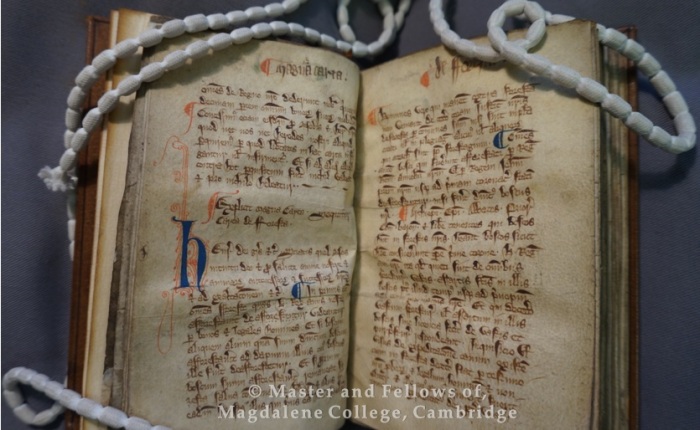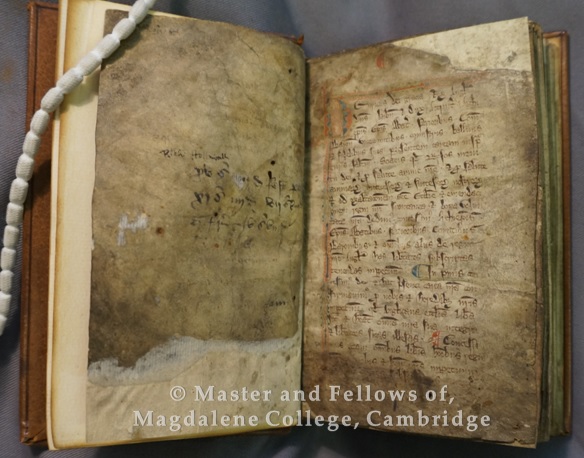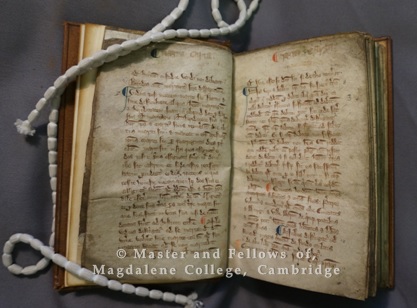There has been much interest in Magna Carta in its 800th year and the Magdalene Old Library can contribute a little-studied example to the growing body of evidence for the wide use of this key document in fourteenth-century everyday legal practice. The Magdalene Magna Carta is not one of the original charters from 1215 or 1225, and has none of those iconic seals. What we see here is one of the dozens (hundreds even) of copies carefully written out through the Middle Ages for lawyers in the form of a portable statute book.
Such copies bear witness to the longevity of the terms of the charter. Magdalene College Cambridge MS F.4.32, is an early example. It dates from the first years of the fourteenth century, just after Magna Carta was confirmed as part of statute law by Edward I (1297). The manuscript, written in a highly readable charter hand anglicana cursiva, comprises key elements (a sort of ‘executive summary’) of many different statutes, of which Magna Carta from the revised version of 1225 is the first. As one would expect it is followed by the Carta de Foresta (Charter of the Forest) establishing rights to erect buildings in the forests, prohibiting execution for crimes such as poaching and reducing the king’s powers to levy fines; and these two precede a host of statutes in Latin and Anglo-Norman, including those of the Exchequer (statutes scaccarii). Other examples of such early portable volumes survive. Two such can be found in the Library of Congress [LAW: Office Magna Charta De Ricci 135] and Trinity College Dublin MS 2352. It is the miniature, business-like nature of these volumes which is intriguing, contrasting sharply with the spectacle and flamboyance of the charters themselves. The Magdalene manuscript is only 13 cm x 8.5 cm. It has a modern binding, and the relative wear and discoloration of the first and last folios suggest that it spent much of its life unbound, probably carried about within a vellum wrap.
It might have been owned at some stage by a “Richard Hollinworth”, whose name appears on the book in a later hand. (The redoubtable M R James, in his catalogue of the manuscripts of the Magdalene Library, records the surname — with a question mark — as ‘Holnwell’, but on close inspection that seems incorrect). This might be the Richard Hollinworth who was at Magdalene (matriculated 1623, BA 1626/7, MA 1690 ) and went on to be a Presbyterian thinker in Manchester. Hollin(g)worth gave four medieval manuscripts to Magdalene, as we know from a Register of benefactors dated 1640 (Magdalene College Cambridge MS F.4.33], and perhaps this was one of them. The signature is not unequivocally his, however, and has only a passing resemblance to Hollinworth’s writing in his manuscript of a history of Manchester, where a much more lavish letter ‘R’ is prevalent (see the following link). If Hollinworth did own this volume, perhaps it was not merely out of antiquarian interest: a knowledge of the fundamental basis of English Law would have been essential to him in his attacks on the Anabaptists.
Among the most important statutes in Magna Carta was a clause establishing the freedoms of the City of London and extending them to other towns and boroughs. “The City of London shall have all the old Liberties and Customs which it hath been used to have. Moreover, we will and grant, that all other Cities, Boroughs, Towns, and the Barons of the Five Ports, and all other Ports, shall have all their Liberties and free Customs.” This is one of the few thirteenth-century statutes that have not yet been repealed.
Yet, despite refinements of the statutes and developments in legislation over subsequent centuries, it is difficult to overstate the importance of these early efforts to establish the relationship between the individual citizen and the Law: “To this day, it remains fundamental that we are all subject to the law, and equal under it, and without equality before the law, we do not enjoy any rights whatsoever.” [From Sir Robert Rede’s Lecture, delivered 10th February, 2014 by The Right Honourable Lord Judge, Honorary Fellow of Magdalene College, Lord Chief Justice of England and Wales 2008-13]
The Magdalene statute book containing Magna Carta was on display recently in our exhibition of ‘Manuscripts of the Old Library’. This exhibition, in which many manuscripts were exhibited publically for the first time, was a prelude to the launch of a new on-line catalogue of the College’s collection planned for later this year. However, a printed catalogue of the exhibition is available now for £2.50 plus post and packing.
Dr M. E. J. Hughes
Pepys Librarian, Keeper of the Old Library and Fellow in English



Pingback: Magna Carta at Magdalene | magdalenelitfest